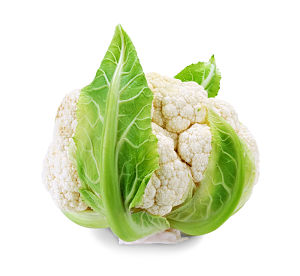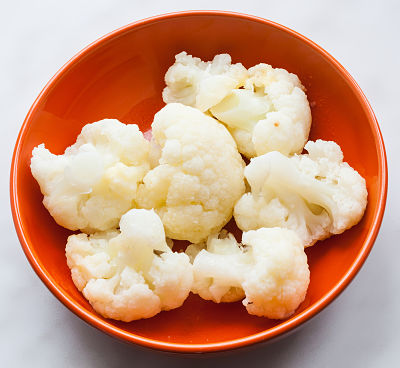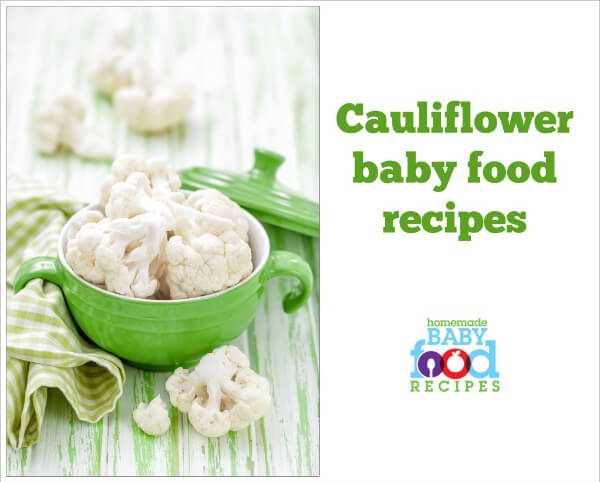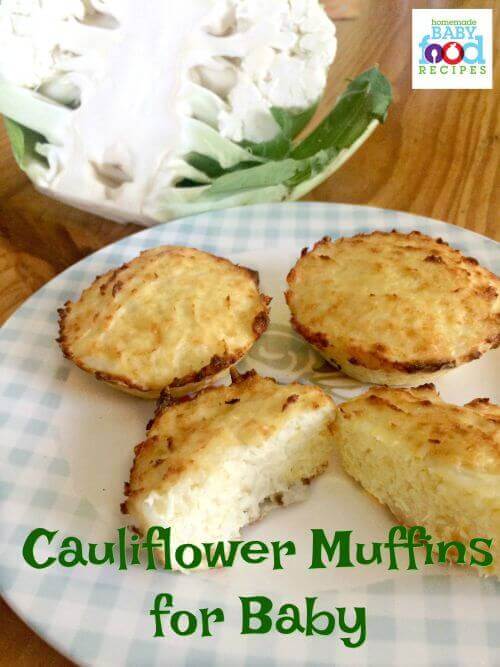Cauliflower Baby Food Recipes
Updated: May 12, 2023
These cauliflower baby food recipes will make eating this nutritious veggie a treat – rather than an ordeal – for your little one!
Because if there’s one vegetable that makes us shudder when we recall it from our childhoods, it’s cauliflower!
We’ve grown to love it since, but the sad truth is that there are many people whose memories of cauliflower – as a watery, unappetizing mush that made the house smell awful – have put them off it for life!
And what a shame that is, because cauliflower is one of the most nutrient-dense veggies around and – cooked properly – can also be one of the most delicious!
This page is designed to help you prepare cauliflower for your baby in ways he’ll truly enjoy!
So let’s get cookin’…
When can my baby eat cauliflower?

Cauliflower can be introduced to your baby from 6 months of age (with your doctor’s consent, of course).
We don’t recommend cauliflower as a first food if your baby is starting solids before 6 months of age, because it has a tendency to cause gas (wind).
For the same reason, you may wish to delay its introduction past the 6 months stage – maybe until around 8 months or older – particularly if your little one has a sensitive tummy!
Cauliflower is NOT considered to be a ‘high risk’ food in terms of allergic reactions.
Nevertheless, you should still introduce it separately (following the four day rule), which will help you identify it as the culprit if it does cause any type of reaction or seems to make your baby gassy!
Is cauliflower good for my baby?
Gas aside, cauliflower is a wonderfully nutritious vegetable and well worth including in your baby’s diet on a regular basis!
It contains lots of vitamin C, is high in fibre and is a good source of folate and B vitamins.
It also contains some calcium, but not so much in the curd as in the green leaves (so do remember to add them to your homemade broth, as per our preparation tips below!).
Cauliflower is rich in anti-oxidants called phytonutrients, which help protect our bodies from serious diseases like cancer and help support a healthy heart.
The creamy white head of a cauliflower is called a ‘curd’ – and it’s white because the cauliflower leaves protect it from the sun, preventing the formation of chlorophyll.
If you’re very lucky, you may be able to find a cauliflower with a purple curd, which contains lots of the antioxidant anthocyanin (red cabbage also contains anthocyanin, which is why it’s red!).
There’s also such a thing as an orange curd cauliflower, which is very high in vitamin A, but we’ve yet to see one of those for ourselves (please do let us know if you’ve ever tried one!).
Cauliflower is a cruciferous vegetable, related to Brussels sprouts, kale – and most closely to broccoli (in fact, broccoli and cauliflower can be used interchangeably in most recipes).
You might even come across a ‘broccoflower’ in your local produce aisle, which may look like a green curd cauliflower, or may have strange, alien-looking spikes (this type is better known as Romanesco broccoli).
How to choose and store cauliflower
When buying cauliflower, look for one that’s heavy for its size.
Check the leaves – they should be fresh, green and ‘snappy’.
If they’re pale and wilted, then the cauliflower is past its prime! And the more leaves on the head, the better, because they help protect the curd and keep it fresh.
The size of the cauliflower has no bearing on either its quality or nutritional value, so simply buy according to the amount you need.
The curd should look a creamy white colour – dull coloured curds, brown spots, or the formation of flowers on the curd are all signs that the cauliflower is old – and subsequently less nutritious than it should be.
Only buy pre-cut cauliflower florets if you plan to use them that day…
They deteriorate very quickly and both the taste and the nutritional value begin to decline after only one day in the fridge!
Avoid frozen cauliflower unless you’ll be using it for soup.
Frozen cauliflower tends to be horribly soggy when cooked and doesn’t even make a very good puree.
We’ve found soup to be the only dish where we can get away with using frozen cauliflower!
To store cauliflower, experts recommend turning it stem side up, to prevent moisture from settling on the curd.
We’d also suggest that you store it in a paper bag – or no bag at all – because moisture tends to accumulate in plastic bags, making your cauliflower rot more quickly.
Fresh cauliflower will keep for up to a week in the fridge.
How to prepare cauliflower for your baby
Simply strip off the green leaves and cut the florets away from the base, just above the stem.
Then, give them a thorough wash under running water.
Don’t throw the leaves OR the stem away – they add an excellent flavour to homemade vegetable stock!
You can then divide the curd into smaller florets – it’s best to try to keep them all the same size, so they cook at the same time.
Leave them to sit for a few minutes after cutting – this is believed to help the health-promoting phytonutrients in the vegetable to develop.
Now you can move on to the cooking stage…
Cauliflower florets are best steamed – which, depending on their size – should take around 8 minutes.
They may also be boiled (in approximately 5 minutes), but it’s important to remember that some of the nutrients will leach into the cooking water.
If you do choose to boil cauliflower, then reserve the cooking water to add back into the cauliflower when you puree it.
Something else to note when boiling cauliflower…
Depending on your cookware, it may discolour.
Aluminium pots can turn florets yellow – iron pots may turn them a lovely shade of blue-ish green!
Adding a little lemon juice to the water can help prevent the problem.
Cauliflower may also be roasted (a method used in one of our recipes below) and can be eaten raw when your child is older (although it does have a slightly bitter taste when raw and has never been a big hit with any of our children!).
Cauliflower baby food recipes
Cooked cauliflower makes a great finger food for older babies – we add a little turmeric to the florets as we cook them, which is not only healthy, but also makes them look colourful and interesting!
The way we do this is to mix turmeric with olive oil, toss our cauliflower florets in the mixture, then cook them in the oven at 400 deg F (200 deg C) for around 20 to 30 minutes, until tender.
Yummy!
Here are some more delicious baby food ideas using cauliflower…
Basic Cauliflower Puree
- Simply steam evenly sized cauliflower florets for approximately 8 minutes, until tender, or simmer in a little water (reserving the water once drained).
- Transfer to a food processor and blend to a puree, adding a little breast milk, formula (or some of the cooking liquid) to thin if necessary.
Gourmet Cauliflower Puree
cauliflower
milk (breast milk or formula if you prefer)
olive oil
chives
- Simmer evenly cut cauliflower florets in the milk until fork tender.
- Drain (reserving the milk) then transfer to a food processor.
- Blend to a puree with a drizzle of olive oil, adding some of the reserved milk to thin if necessary.
- Finally, stir in finely chopped fresh chives.
Cauliflower and Baked Apple Mash
A tasty sweet and savoury combo that just may tempt your little one if he hasn’t liked cauliflower up to now!
around 1/2 lb cauliflower florets
1 small apple
little butter (optional)
- Steam the cauliflower until tender.
- Meanwhile, preheat the oven to 375 deg F (180 deg C).
- Score the apple with a knife, drizzle with olive oil and place on a baking sheet.
- Cook for 30 to 45 mins, until the apple is soft. Cool to a safe handling temperature.
- Remove the skin and core of the apple.
- Mash (or puree) the cooked cauliflower with the cooked apple, adding a little butter if desired.
Easy Cauliflower and Apple Puree
1 apple, cored and sliced (may be left unpeeled – see this page for more information)
around 1/2 small head of cauliflower, divided into florets
4 to 6 fl oz (1/2 to 3/4 cup) low sodium or homemade chicken stock
- Place the apple and cauliflower in a saucepan and pour in the stock (start with 4 fl oz and add more if the mixture looks too dry).
- Simmer until the apple and cauliflower are tender.
- Drain, reserving the stock.
- Puree in a blender, adding some of the reserved stock to thin if necessary.
Dreamy Creamy Cauliflower Soup
1 small cauliflower head
1 small carrot, peeled and sliced
1 clove garlic, chopped
1/2 medium onion, sliced
pinch ground cumin
tiny pinch sage
- Heat a little olive oil in a saucepan and cook the onion and garlic until just tender.
- Meanwhile, divide the cauliflower into evenly sized florets.
- Add the florets and sliced carrot to the pot, stir well, then pour in enough water to just cover.
- Bring to the boil, then reduce the heat and simmer until all the ingredients are tender (around 15 mins).
- Transfer to a food processor (or blend in the pot using a hand blender) and puree until smooth, adding the cumin and sage as you do so.
- Serve when the soup is at a safe temperature.
TIP: You can use vegetable or chicken stock instead of water in this recipe – or, if you’d like it extra creamy, you can even use milk!
Baked Cauliflower Cheese
1 small head of cauliflower (around 1 lb)
4 tsp unsalted butter
6 fl oz (3/4 cup) milk
pinch nutmeg
1 oz (1/4 cup) grated Cheddar cheese
1 oz (1/4 cup) grated Parmesan cheese
2 tbsp fresh whole wheat bread crumbs (here’s how to make them)
- Preheat the oven to 375 deg F (180 deg C).
- Divide the cauliflower into florets and steam until tender.
- Meanwhile, melt half the butter over a low heat, then stir in 2 tsp flour. Cook, stirring constantly, for 2 mins.
- Add the milk slowly, stirring constantly, and bring the mixture to a boil.
- Cook until thick (around 1 minute).
- Remove from the heat and stir in the nutmeg and Cheddar cheese.
- Add the cooked cauliflower, stir well and place in a baking dish.
- Stir the Parmesan cheese into the bread crumbs, then sprinkle them over the cauliflower/cheese mixture.
- Melt the remaining butter and drizzle it over the top.
- Bake for between 20 to 30 mins, until golden in colour.
Garden Vegetable Bake
This recipe makes a substantial dish which you can use as a main vegetarian meal for the whole family, or serve as a delicious side with meat!
2 oz (1/4 cup) unsalted butter
8 oz (2 cups) grated Cheddar
2 white potatoes, peeled and sliced
1 medium head of broccoli
8 oz (1 cup) frozen peas
4 tbsp chopped, fresh chives
6 tbsp flour
1 medium head of cauliflower
- Preheat the oven to 400 deg F (200 deg C).
- Divide the broccoli and cauliflower heads into florets.
- Melt the butter in a saucepan over a low heat and carefully stir in the flour. Cook briefly.
- Slowly add the milk, stirring constantly, and continue to cook for a minute or two until thickened.
- Remove from the heat and stir in the cheese, saving a handful to put on the top.
- Meanwhile, put the sliced potatoes into a saucepan and cover with water. Bring to the boil, reduce the heat and simmer for 5 mins.
- Add the broccoli and cauliflower florets and cook for 4 mins more.
- Add the frozen peas, bring the mixture to a boil, then remove from the heat.
- Drain well, then stir the veggies and chopped chives into the cheese sauce.
- Top with the rest of the cheese and bake for between 20 to 30 mins until golden.
Nutrient-Packed Mashed Potato
If you’re having difficulty in getting your baby to eat cauliflower, then try this recipe – it’s super tasty and looks just like cheesy mash!
1/2 lb baking potatoes
around 4 cauliflower florets
3 tbsp warm milk
2 tsp olive oil
1 oz (1/4 cup) grated Cheddar cheese
1 tbsp fresh, chopped chives
- Peel the potatoes, cut into 2 inch pieces and simmer in a saucepan of water for 10 mins.
- Add the cauliflower florets and cook for around 6-8 mins more, until the potato and cauliflower are tender.
- Drain well.
- Mash the potato and cauliflower together with the cheese and chives, then stir in the milk and olive oil.
Cauliflower, Squash and Pear Mash
4 oz (1/2 cup) butternut squash, peeled and cubed
4 to 5 cauliflower florets
1 small pear, peeled, cored and cut into chunks
1 tbsp olive oil
1 small garlic clove, crushed
1 tsp fresh chives
- Preheat the oven to 400 deg F (200 deg C).
- Stir the garlic and chives into the olive oil, the toss the fruit and veggie chunks in the oil until coated.
- Place on a baking sheet and cook for 45 mins to 1 hour until all the ingredients are tender.
- Mash well or puree, adding a little water, broth or milk to thin if needed.
Don’t miss our unique baby MUFFIN recipe…
Homemade baby food equipment…
Homemade baby food accessories
Sources:
Cauliflower: A versatile nutrition superstar (Mayo Clinic)
PubMed.gov – The Purple Cauliflower




